Is An Air-Fryer More Energy Efficient Than An Oven?
At first glance, the question I'm asking in this post almost seems redundant: an air fryer has to heat a much smaller area, and uses a smaller heating element, so of course it should be more energy efficient.
However, that's not guaranteed to be the case.
Although an oven uses a larger heating element, because it's better insulated, it's possible that it might do a better job of keeping heat in and so have to consume less energy replacing lost heat. If, due to these losses, the air-fryer's element is on for more of the duration of the cook, it's plausible that an air-fryer might end up consuming more energy than the oven.
If (as seems likely) the air fryer is more energy efficient, the question becomes:
- How much more efficient?
- When does it amortise (i.e. at what point do the energy savings outweight the initial purchase cost)?
That second question will also help answer the question of whether it's worth investing in an air-fryer to try and counter high energy prices.
In this post, I cook myself some chips and compare the resulting energy usage using
- An Oven: A Rangemaster Professional (Oven is 3.2 kWh)
- An Air-Fryer: 1700w 5.5L Air Fryer
To see how they compare.
If you're not interested in how I actually arrived at them, there's a set of TL:DR's at the bottom of this post:
- Is an air-fryer more energy efficient than an oven?
- When Will I Break Even?
- Should I invest in an Air-Fryer to avoid high energy prices?
The Cook
Both the oven and the air-fryer cooked the same thing: Co-op own brand frozen oven chips.
The appliances are situated in the same kitchen, but at opposite ends (so the air-fryer's not gained the benefit of heat radiating from the oven warming the air it draws in).
Although they're cooking the same food, there are some differences:
- the oven requires 25 minutes and the air-fryer 15
- The oven needs to be set to 180°c (from the food packaging) whilst the air-fryer manual says to use 200°c
Unlike the oven, the air-fryer doesn't need to warm up first, cutting 15-20 minutes off the run time (depending on how long it takes you to come back and put food into the oven).
The oven started first. When the air-fryer finished the oven was turned off and the food taken out of both.
As with my previous forays into measuring energy consumption, energy usage readings were collected and written into InfluxDB so that statistics could be queried back out with Flux.
Retrieving Results
Because of the way it's wired in (into it's own circuit, with no convenient access to the wiring for a clamp meter), calculating the oven's usage requires a slightly more complex query than is normally required for individually monitored appliances.
The way usage is calculated is
- Retrieve usage for all invididually monitored devices
- Retrieve usage for power meter
- Subtract the sum of device usage from the power meter (details on how I collect this here)
- Subtract a known base load figure (to account for items not monitored) to arrive at the Oven's usage
There is a small margin for error involved in the subtraction of the base load, but it really is quite small: I've been doing a lot of work recently understanding our base load (to find where it can be reduced).
The Air-Fryer was plugged into a Tapo P110 Smart Socket, so it's usage can easily be collected and queried.
I wrote a Flux query to retrieve and combine usage data for each of the appliances into a single output stream
// Start/Stop times
start = 2022-09-04T16:40:00Z
stop = 2022-09-04T17:30:00Z
// Group into 30s time windows
// helps ensure meter and appliance readings appear in the same window
period = 30s
// get appliance usage
known = from(bucket: "Systemstats")
|> range(start: start, stop: stop)
|> filter(fn: (r) => r._measurement == "power_watts" and
r._field == "consumption")
|> filter(fn: (r) => r.host != "power-meter")
|> aggregateWindow(every: period, fn: mean)
// Combine all appliances into a single table
|> group()
// Calculate the combined consumption per window period
|> aggregateWindow(every: period, fn: sum, createEmpty: true)
// Get total usage measured at the meter
pm = from(bucket: "Systemstats")
|> range(start: start, stop: stop)
|> filter(fn: (r) => r._measurement == "power_watts" and
r._field == "consumption")
|> filter(fn: (r) => r.host == "power-meter")
|> aggregateWindow(every: period, fn: mean)
// Join the two
oven = join(tables: {t1: pm, t2: known}, on: ["_time"])
// subtract appliances + base load to get oven usage
|> map(fn: (r) => ({
_time: r._time,
_field: "Oven",
_value: r._value_t1 - r._value_t2 - 400.0
}))
// Get the air fryer's usage over the same period
airfry = from(bucket: "Systemstats")
|> range(start: start, stop: stop)
|> filter(fn: (r) => r._measurement == "power_watts" and r._field == "consumption")
|> filter(fn: (r) => r.host == "air-fryer")
|> aggregateWindow(every: period, fn: mean)
// Union the tables so we can display a graph with 2 series
union(tables: [oven, airfry])
This gives us the following graph
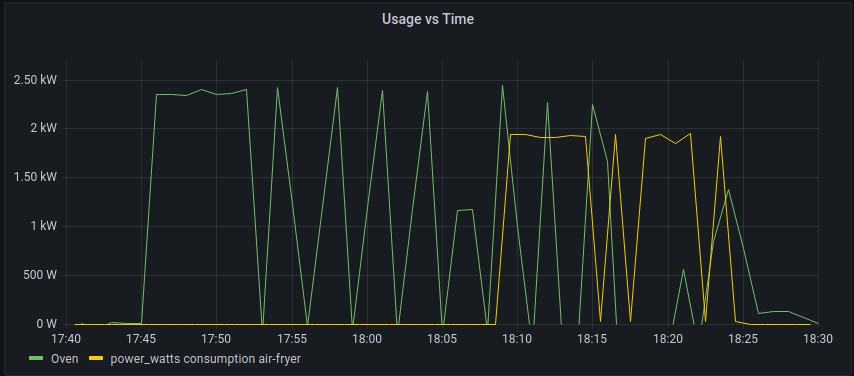
It's already fairly apparent which appliance is going to be responsible for most usage.
All subsequent statistics in this post are retrieved by appending to the union() statement in the query above.
Mean Usage
If we look at the mean draw across the cook
start = 2022-09-04T16:40:00Z
stop = 2022-09-04T17:30:00Z
...
// Union the tables so we can display a graph with 2 series
union(tables: [oven, airfry])
|> mean()
|> group()
We see that the oven's average usage is significantly higher
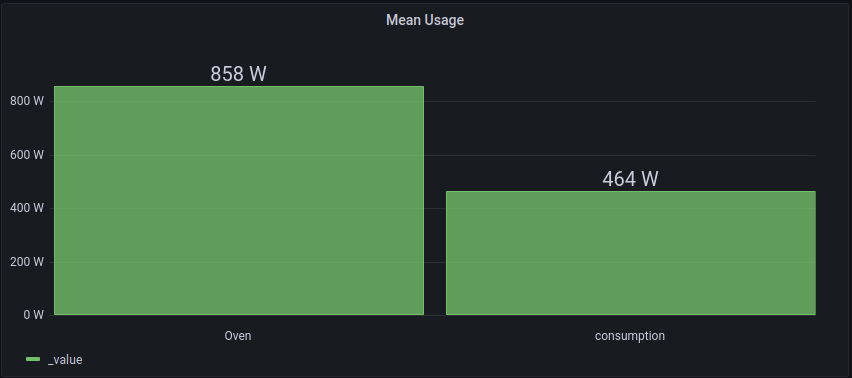
Total Usage
We know what the average draw is, but let's look at the total power consumption for each appliance.
Calculating consumption from draw is fairly easy: If we draw n watts for an hour, then the usage is n Wh (with 1000 Wh being 1 kWh). If we draw n watts for 1/xth of an hour, then we need to divide n by x to have the calculated usage represent that fraction of time.
For example:
A 30 second 3kW draw consumes (
3000 / (60 * 2)):25 Watt hours.
Our data is windowed into 30 second periods (1/120th of an hour), so each window consumes 1/120th of the calculated usage.
So, to implement this, we add a simple conversion to the end of the query, taking the draw for that period and dividing it by 120:
// Union the tables so we can display a graph with 2 series
union(tables: [oven, airfry])
|> map(fn: (r) => ({ r with
// data is grouped into 30s windows, so if we're pulling 2kW
// in that window we're consuming
//
// usage / (mins-in-hour * 2)
// 2000 / 120
//
_value: r._value / 120.0
}))
// Calculate totals
|> sum()
|> group()
Giving the following results
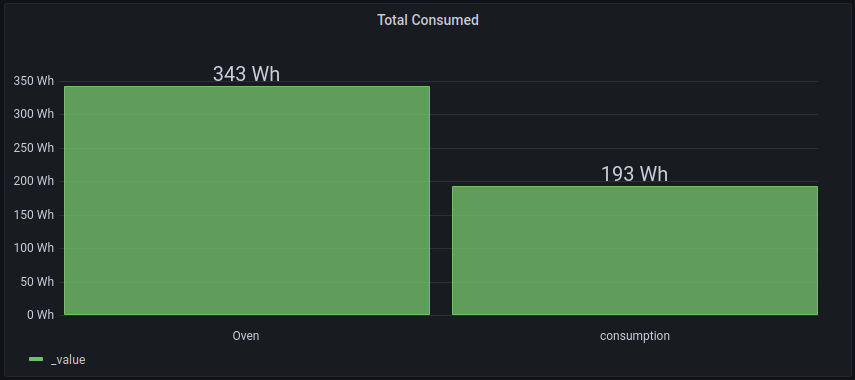
The oven consumed more than double the energy demanded by the Air-Fryer. Unsurprisingly, the proportions here are very similar to the proportion between the two appliance's mean draw (the two figures being quite well correlated).
However, the oven did need to warm up first. What happens if we only look at the time spent cooking (i.e. when food was in there)?
To do that, we adjust the start time at the head of the query so that the query starts after the oven has completed it's warm-up
start = 2022-09-04T16:59:00Z
The result is a large reduction in the reported consumption
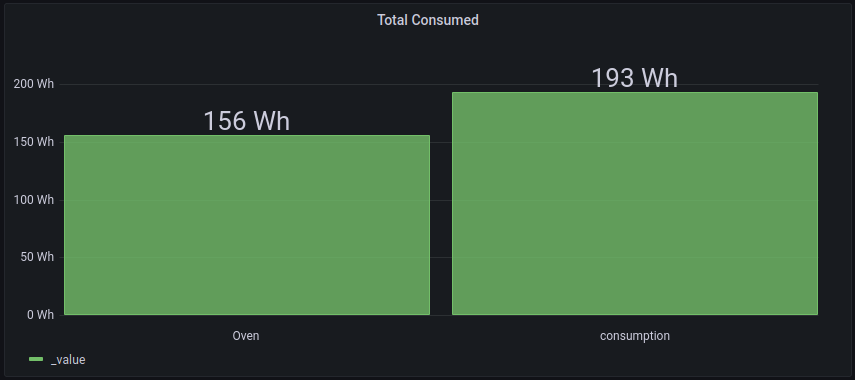
The oven has a significant edge, managing to outperform the air-fryer (which, even if it is able to do so whilst cooking, had to warm-up during that time).
Warm Ups
Of course, you may be thinking that this statistic isn't particularly useful: you can't reliably cook food without warming the oven.
However, the fact that the oven's post-warmup consumption is lower than the air-fryer raises the possibility that the oven might be able to outperform the air-fryer when cooking over longer periods.
To understand the usage, we start by looking a little closer at the warm-ups:
- How long does warm up take?
- What power is consumed during that time?
- What's the consumption with that subtracted?
Because both devices have thermostatic control, we can easily tell when they came up to temperature: there's a corresponding drop in power consumption where the thermostat turns the heating element off.
You can see the warm up periods highlighted in the graph below (red: oven, purple: air-fryer)
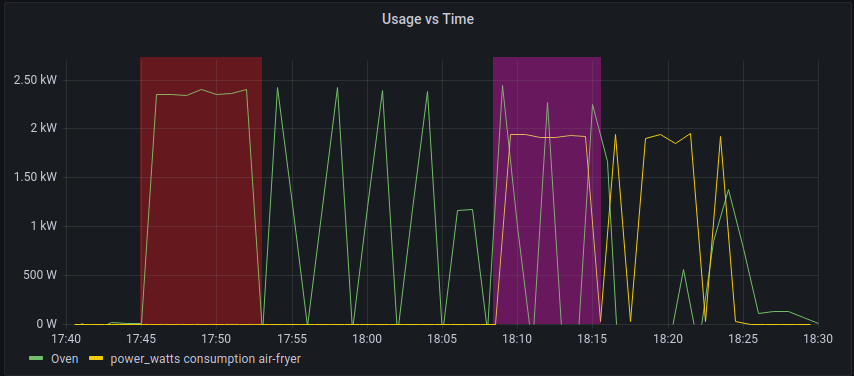
The warm-up timings were
- Oven: (17:45 - 17:53) 8 minutes
- Air-fryer: (18:08 - 18:15) 7 minutes
Of course, in practice the oven sat not cooking anything for longer than 8 minutes because I'd wandered off to do other things and took a little too long to come back. Although that's representative of real usage (or, certainly, representative of my usage) we won't penalise the oven for my mistake when we do our calculations.
By changing the start and stop values on the query we get consumption for each of the warmup windows, before taking the usage from the warm-up periods and subtracting them from each of the total usage figures:
| Device | Warm Up Usage | Remaining Usage |
|---------------------------------------------|
| Oven | 137 Wh | 206 Wh |
| Air-Fryer | 96.4 Wh | 96.6 Wh |
-----------------------------------------------
Although interesting, they don't tell us much on their own - we'll use these figures later.
Heating Element Activity
One thing which stands out in the graph is how long the air-fryer's element spends active after the initial warm-up.
It's a horrible visualisation, but look at how much longer the air-fryer element is active (the purple boxes) per instance than the oven (red boxes):
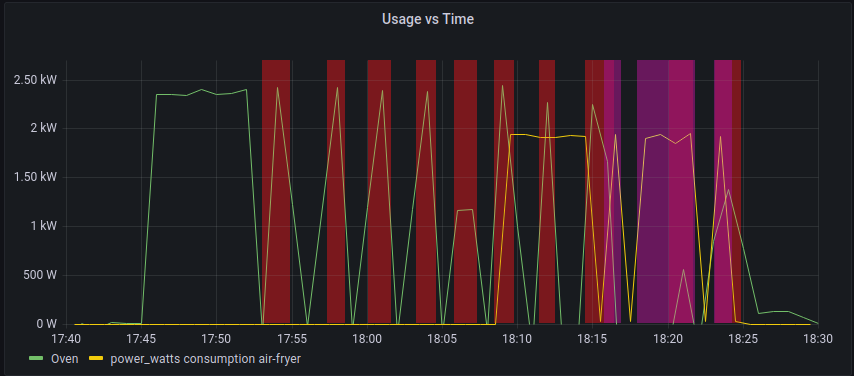
The oven mainly has 30 second bursts (though there are a couple of 1 minute periods mixed in). Conversely, although the air fryer has a couple of 30s bursts, there's a 3 minute period where the element is constantly active.
This would seem to support the idea that the Oven is able to maintain temperature much more easily than the air-fryer.
We can check how long the element in each device spent turned on
union(tables: [oven, airfry])
// Set a state to group by later
|> map(fn: (r) => ({r with
state: if r._value > 1100 then
"ON"
else
"OFF"
}))
// Calculate the total stateduration
|> elapsed(unit: 1s)
|> filter(fn: (r) => r.state == "ON")
|> sum(column: "elapsed")
|> group()
By changing the start and end times we can see how long the element was active during each state of the cook
| Device | Total | After Oven Warmup | After Air-fryer Warmup |
|------------------------------------------------------------------|
| Oven | 22 mins | 14 Mins | 1 Minute |
| Air-Fryer | 12 mins | 12 Mins | 6 Minutes |
--------------------------------------------------------------------
50% of the air-fryer's activity occurred after warmup, whilst 63% of the oven's heating time occurred post warmup.
But the oven was also on for longer (making it's post-warmup time disproportionaly larger than the air-fryers), so we need to make the comparison proportional by taking the total cook time into account:
| Device | Cook Time (exc warmup) | Element Time (exc warmup) | Element Time |
|-------------------------------------------------------------------------------|
| Oven | 32 Mins | 14 Mins | 43.75% |
| Air-Fryer | 10 Mins | 6 Mins | 60.00% |
---------------------------------------------------------------------------------
The air-fryer spent significantly more of it's non-warmup time with the element sucking power.
So, it's certainly possible that the oven could prove to be more energy efficient after a period of time.
Can the Oven be more efficient?
We can work out roughly where the break even falls: if we reduce the post-warmup average consumption to a per minute average we can compare them in order to predict how many minutes of cooking time it would take for the Oven to outperform the Air-fryer.
We collected the figures that we need above:
| Device | Cook Time (exc warmup) | Power Consumed (exc warmup) | Power consumed (Warmup) |
|--------------------------------------------------------------------------------------------|
| Oven | 32 Mins | 206 Wh | 137 Wh |
| Air-Fryer | 10 Mins | 96.6 Wh | 96.6 Wh |
----------------------------------------------------------------------------------------------
To calculate the average Wh consumed per minute, we do
Consumed / time = average minutely consumption
Giving the following figures
- Oven:
206 Wh/32 mins=6.4375 Wh/min - Air Fryer:
96.6 Wh/10 mins=9.66 Wh/min
The oven is significantly more efficient per minute.
But before that efficiency advantage can translate into an overall energy saving, the oven first has to cancel out the additional energy it consumed during it's warmup period.
To calculate when it'll reach that point, we calculate the difference in warmup consumption, and then divide by the difference in per-minute consumption
137 - 96.6 = 40.4 Wh
------------------------------- = 12.54 minutes
9.66 - 6.4375 = 3.2225 Wh
So, all things being equal, the oven would break even after ~13 minutes.
But, all is not equal: The air-fryer also requires less cooking time (10 minutes less for chips), so the Oven spends an extra 10 minutes consuming energy.
Adding this into our calculation moves the break-even point quite considerably:
(137 - 96.6)
+ (10 * 6.4375) = 104.757 Wh
-------------------------------- = 32.51 minutes
9.66 - 6.4375 = 3.2225 Wh
At nearly 33 minutes, this is more than double the time that the air-fryer requires to cook the chips.
Spuds
15 minutes is quite a short cook time though, so does this hold for something which requires longer?
If we take the timings from two baked potato recipes (oven and air fryer), we should be able to work out which is more energy efficient:
- Oven potatoes require 75-90 mins (we'll split the difference and call it 83)
- Fryer potatoes require 50 mins
The Oven potatoes need 33 mins more, so, assuming that warmup and per-min consumption doesn't change:
(137 - 96.6)
+ (33 * 6.4375) = 252.84 Wh
-------------------------------- = 78 minutes
9.66 - 6.4375 = 3.2225 Wh
The break-even is at 78 minutes, which (again) is longer than the air-fryer needs.
Technically, the break-even will be even further out than that because the oven recipe requires a higher temperature than our chips, so the warm-up and maintenance consumption would be higher.
To summarise then: Post-warmup, an oven uses less energy per minute than an air-fryer does, but because the air-fryer needs substantially less time to cook food, it still uses less energy overall.
Purchase Break-Even
Given the energy crisis looming in the UK, it'd be remiss not to also look at the financial side of this.
If you're reading this, it's possible you haven't yet bought an air-fryer, and are considering doing so in order to reduce your energy bills. You probably already have an oven, so the upfront cost comparison is £0 vs $airfryer_cost.
To identify whether it's worth buying an air-fryer, we need to look at how long it'll take for the energy savings to break even with the purchase cost (known as amortisation).
If we consider the following:
- The Air-Fryer I tested costs
£72.99(although you can get an Air Fryer for around £40). - Including warm-ups (let's be realistic, you're never going to consistently leap on the oven as soon as it's warmed up), the air fryer consumed
150 Whless than the Oven when cooking chips. - In October, the cost of electricity will (for many) rise to
£0.52/kWh
We can conclude that
- The air-fryer saved (
52/1000 * 150)£0.078in energy when cooking my chips - At £0.078 per cook, break even would happen after (
72.99 / 0.078) 936 similar cooks
At one cook a day, it would take two and a half years for the energy savings to offset the £72.99 purchase price. Assuming a £40.00 air-fryer is able to deliver the same energy savings, it would still take nearly 18 months to break even.
To put that into perspective:
- If I were to cook chips once a day for 31 days, I would reduce my energy bills by just
4.65 kWh/£2.41a month. - If I spread the cost of the air-fryer, interest free, over the course of 18 months, I would pay
£4.05/month - Despite the energy saving, I'd therefore lose
£1.64a month
It's (hopefully) unlikely that you're going to be living off chips alone though, so let's also project usage for baked potatoes:
Oven: 137 + (83 * 6.4375) = 671.31 Wh
- Air-fryer: 96.6 + (50 * 9.66) = 579.6 Wh
-------------------------------------------
91.71 Wh
The saving on baked potatoes is actually lower, and saves (52/1000 * 91.71) £0.0477 per cook (giving a 4 year amortization period).
This means that, even if you manage to find an air-fryer at half the price I paid, the break-even is still years away.
Conclusion
Despite needing to achieve a higher temperature, the air-fryer used significantly less power cooking my chips.
The fact that it doesn't need to be warmed up first contributes quite significantly to this: not just because it's not spending time heating rather than cooking, but also because it removes the opportunity for a human to get side-tracked and forget to put the food in (guilty, your honour).
The oven actually consumes significantly less energy maintaining temperature than the air-fryer does (likely because of better insulation), but this is mitigated by the air-fryer's faster cook time, allowing it to deliver lower over-all energy consumption.
So, to answer our questions:
Is an air-fryer more energy efficient than an oven?
Yes, but only if you use it properly and adjust cooking times.
If you air-fry food for the same amount of time as you would in an Oven, it may take as little as 13 minutes for the Oven to become the less expensive option (and your food will probably be horribly burnt).
Even at the insane prices we're all going to be paying, the savings per-meal are very small and it'll likely take years for the energy savings to break even with the up-front cost of purchasing an air-fryer. In some cases, it may take longer than the useful life of the air-fryer.
Should I invest in an Air-Fryer to avoid high energy prices?
The long amortisation period means that if you're concerned about how you're going to afford energy bills this winter, purchasing an air-fryer isn't a good way to address it.
The air-fryer will reduce your energy consumption, but only very slightly and the up-front purchase cost will mean that you're worse off overall.
Unless you can find a very deeply discounted air-fryer (or be gifted one, or pay off interest-free over an extremely extended period), it's unlikely to be the right way to go from a purely financial point of view.
Obviously, if you already have an air-fryer, then you've already incurred the capital cost, so using it where you can will (slightly) reduce your energy bill, with each saving bringing the break-even point slightly closer.
And, they do make some very nice chips.
Update: Cooking at 180
After I published this post, a Twitter user raised an interesting point
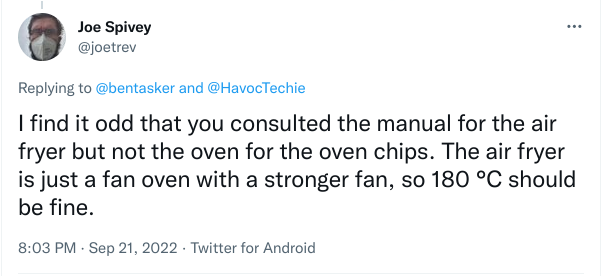
The Oven's manual doesn't provide any guidance, but it's true that I could have tried cooking in both at 180c, demanding lower consumption from the air fryer and increasing it's overall advantage.
My expectation was that it wouldn't make much material difference to the conclusion of this post, but I thought I'd give it a try none-the-less.
This evening, I cooked some chips using the following
- Temperature: 180c
- Time: 15 minutes (as before)
The chips came out cooked, but, honestly, really weren't that great - they hadn't crisped very much and had that unpleasant wet oven-cook feel to them. They either needed longer, or the manual's recommended temperature. But, what we're interested in is the power consumption.
Consumption was graphed using the same query as before
period = 30s
from(bucket: "Systemstats")
|> range(start: 2022-09-24T16:45:00Z, stop: 2022-09-24T17:05:00Z)
|> filter(fn: (r) => r._measurement == "power_watts" and r._field == "consumption")
|> filter(fn: (r) => r.host == "air-fryer")
|> aggregateWindow(every: period, fn: mean)
Giving the following graph
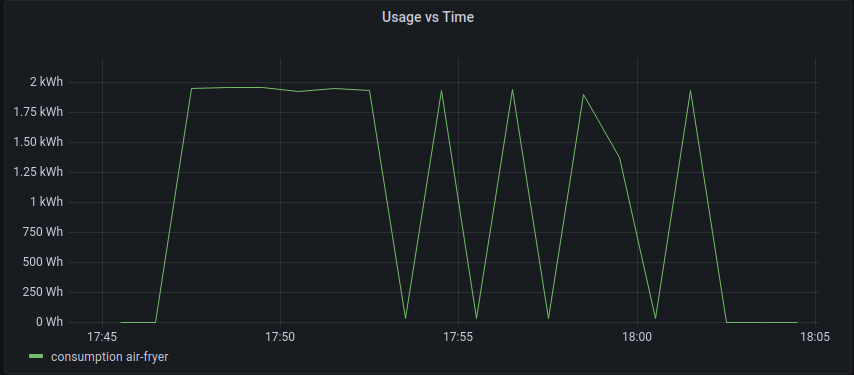
Using the same queries as in the earlier part of this post, we can see that the total consumption for this cook was 174 Wh, just 19 Wh less than the cook at 200 Celsius. So it saved 169 Wh when compared to the oven cook.
If we re-run the break-even calculations using this figure, we can see that
- At 180c it saves (
52/1000 * 169)£0.088in energy - At £0.088 per cook, break even will take (
72.99 / 0.088) 829 similar cooks - At one cook a day, break even is therefore around 2 years, 3 months and 8 days.
- A £40 fryer achieving the same savings would take 1 year, 2 months and 27 days to break even.
- 31 days of chips once a day would reduce energy bills by just
5.24 kWh/£2.72 - Assuming interest free repayment of purchase at
£4.05/month, we'd be£1.33worse off a month
There's also the issue of the quality of the chips we get. Realistically, you're only likely to eat them like that once, and then on subsequent cooks you'll either increase the temperature (back to 200) or the time.
So, let's work out the impact of adding time - what we're interested in is the average power usage whilst the air-fryer is maintaining temperature (the bulk of energy usage being in the initial warmup).
We can see in the graph that the warm up finished at 17:53:30, the cook finished at 18:02:30, making the maintenance period 9 minutes.
During that time it consumed 76.6 Wh, so the average consumption per minute was (76.6/9) 8.5Wh.
Assuming the chips required an additional 5 minutes (in practice, that's probably still not enough), we'd likely consume another 42.5 Wh. The advantage gained by dropping to 180c was only 19 Wh, so we're now worse off by around 23.5 Wh (although still ahead of the oven).
So, although cooking at 180c does reduce the energy consumption a little
- It doesn't make a material difference to the conclusion: it's still a poor solution to energy prices unless you already own one
- You'll save around
£0.009versus cooking at 200c - The chips you get from those cooks won't be nearly as good as those done at 200c.
- Adjusting the cook time to account for the lower temperature results in higher energy usage than the shorter, high temperature cook
One additional concern I've developed since originally writing the post is realistic usage patterns.
The air fryer will save you a little money if you use it instead of the oven. However, because it makes such good chips, it's easy to slip into the habit of using it as well as the oven, increasing your overall power consumption. Having a dual zone air-fryer can help with this a little, but it becomes quite hard to put chips in the oven knowing how much better they'll be from the fryer.

